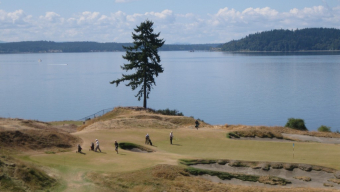CHARLOTTE, N.C. – This performance looked familiar.
Rory McIlroy’s victory Sunday at the Wells Fargo Championship was reminiscent of last summer, when he won three consecutive tournaments to reassert himself as the world’s best player.
We saw the 350-yard, fairway-splitting tee shots. The lofted long-irons that landed softly on par-5 greens. The type of shots that make it an unfair fight.
And the timing couldn’t be better. This was McIlroy’s last start in the U.S. before the U.S. Open.
“It’s just a great momentum builder going into the thick of the season,” McIlroy said of his Wells Fargo win, which came two weeks after he won the World Golf Championships-Cadillac Match Play. Last month, he ranked outside the top 150 in the FedExCup. Now he’s third.
No one knows what to expect from Chambers Bay, the nouveau-links outside Seattle. McIlroy will defend the year’s last two majors at courses where he’s had success, St. Andrews and Whistling Straits. He finished third at both when they last hosted majors in 2010, when he was 21 years old.
McIlroy said Sunday that his game is “very close” to where it was last summer, when he won two majors (Open Championship, PGA Championship) and a World Golf Championships (Bridgerstone Invitational) in successive starts.
He’d like to be more consistent with his putting, which improved this week after a tip from Dave Stockton, especially from 8 to 12 feet. “Most other areas of my game are, I feel, in a really good place,” he said. He led the Wells Fargo field in driving distance (321.1 yards) while ranking 19th in accuracy (55.4 percent). He was second in greens in regulation (77.8 percent) and 21st in strokes gained-putting (+3.21). It led to a tournament-record 27 birdies.
This was McIlroy’s first stroke-play win on the PGA TOUR since last year’s PGA Championship. He also won the European Tour’s Dubai Desert Classic in February.
He finished in the top 11 in five of six stroke-play starts between Dubai and Charlotte, but something always seemed to be off. Frustration caused him to fling a 3-iron into a lake at Trump National Doral. A slow start at Augusta National put Jordan Spieth out of reach. He continued to be confounded by the front nine at TPC Sawgrass.
McIlroy’s seven-shot victory margin on Sunday was padded a bit by Patrick Rodgers’ struggles on the last two holes (he played them 3 over). That’s OK. The real statement was made Saturday.
McIlroy separated himself from the pack with a course-record 61 in the third round. He made 11 birdies – including nine in a 10-hole stretch – and none of them came on a putt longer than 15 feet. Nine of his 11 birdie putts were from 10 feet or shorter.
“He overpowers the golf course. He free swings everything,” said Will MacKenzie, who played alongside McIlroy in that round. “He kind of has that deal with Tiger, when Tiger was at his top.”
In his prime, Woods added to his opponents’ pressure. McIlroy can have the same effect.
“You never expect him to hit bad shots, so you know you have to be that much sharper and that much more on your game,” said Webb Simpson, who finished second to McIlroy on Sunday.
McIlroy will play the next two weeks in Europe, defending his title at the BMW PGA and hosting the Irish Open, before having two weeks off in advance of the U.S. Open. Chambers Bay isn’t your typical U.S. Open layout, though. It’s a beefed-up links course.
Eyebrows were raised when U.S. Golf Association executive director Mike Davis said an early arrival to Chambers Bay is almost mandatory for victory. “The idea of coming in and playing two practice rounds and having your caddie just walk it and using your yardage book, that person’s done,” Davis said. “(He) will not win the U.S. Open.”
McIlroy said he’ll check out Chambers Bay the weekend before the U.S. Open and play three practice rounds.
“What’s Mike Davis’ handicap?” McIlroy asked sarcastically. “Yeah, exactly.
“I think you can fall into the trap of trying to overprepare. If you don’t go out and execute the shots that week, all that preparation doesn’t mean anything.”
No one executes better than McIlroy at his best, so perhaps the mystery could favor him, though he’s won his majors on softer tracks. He’s more familiar with the sites of the next two majors.
McIlroy set a record at St. Andrews, shooting 63 in 2010’s first round to match the lowest score in a major. He got caught in bad weather in the second round, though, and shot 80. He finished T3 after shooting 69-68 on the weekend. It was his only top-20 in The Open until last year’s win.
McIlroy admits he let frustration get the best of him in that second round five years ago. He’s a more patient, more mature player now.
He also has had success in the European Tour’s Alfred Dunhill Links Championship. Two of the tournament’s four rounds are played on The Old Course. He finished third in 2007 in his second European Tour start as a pro and was runner-up last year. He’s finished in the top three in four of six starts in that event.
“St. Andrews, I know very, very well,” McIlroy said. “(It’s) somewhere that I’ve always played well, and a place I really enjoy.”
McIlroy didn’t say the same when he first set eyes on Whistling Straits. He finished one shot outside the playoff between Martin Kaymer and Bubba Watson, which Kaymer won. Everyone except the victor was overshadowed by Dustin Johnson’s unintentional grounding, though.
“I didn’t like it at the start of the week,” McIlroy said. “I told myself, ‘Just like it for this week.’ But at least I know how to play it. I’m going back to a golf course I know, and I’m excited for that.”
Especially if he can continue the form he showed at Quail Hollow.





















